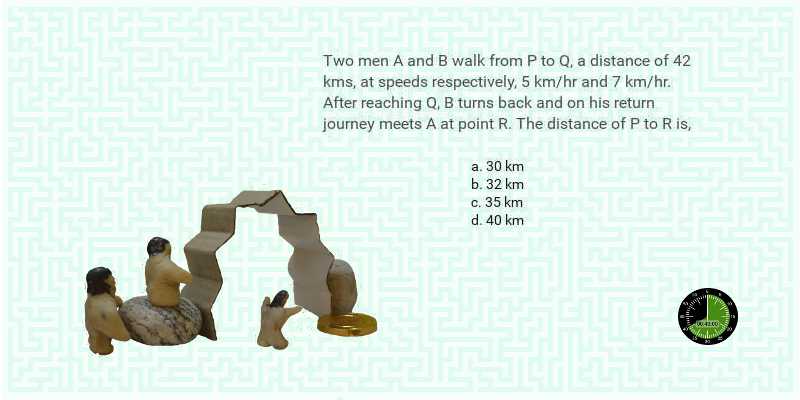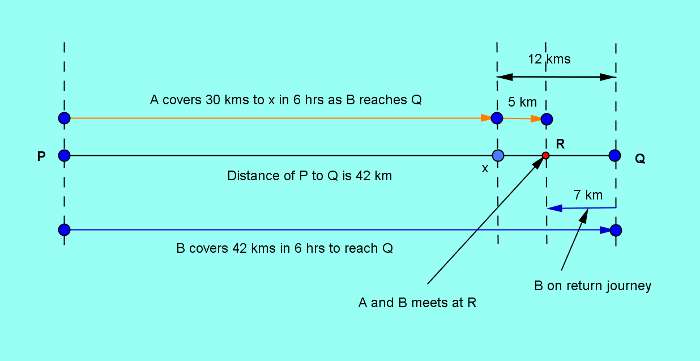Use Problem breakdown and Change analysis techniques to solve the problems in a few simple steps

The problems involving Time and Distance are taught during middle schools and also form an important part of most of the competitive job tests such as SSC CGL, Bank POs etc. In this second session of solving difficult SSC CGL level Time and Distance problems in a few steps, we will solve two chosen problems and analyze the elegant solution process in a few steps.
Basic concept
The core concept in all time and distance problems is governed by the classic relation between the three entities, time, distance and speed.
$Distance = Time\times{Speed}$
This is the most basic relationship between these three elements.
Conceptually this means, for a moving object distance is directly proportional to either speed or time, the other remaining constant. Furthermore, if distance is held constant, this relationship also means time and speed will be inversely proportional to each other.
We can believe this relationship from our every day experience also. If our train moves at a higher speed we will reach our destination in lesser time. That is inverse relationship between the speed and time, where the distance is same in both the journeys at different speeds.
Instead, if we move faster for the same duration we will cover a much larger distance. That is direct proportionality between distance and speed. Here time duration is held constant in both cases of travel.
Rich concept
The derived concept is the concept of relative speed when two or more than two objects move in the same or opposite direction. One object moving faster than another but in the same direction will pass the second object at a relative speed which is the difference between the two speeds.
But if the two objects move in opposite directions, their speed relative to each other will be the sum of the two speeds.
All time and distance sums at school level and that appear in competitive tests are based on these two sets of concepts.
We will take two problems on this topic area of time and distance just to highlight how problems can be solved in just a few simple steps by applying relevant problem solving techniques and strategies along with basic and rich concepts in the topic involved.
We will not present any longer conventional solution for the two problems. It should not be too difficult to find a more involved solution.
Our recommendation is, try to solve both the problems yourself, before going through our solutions. Your learning will be better this way.
Problem 1.
Two men A and B start simultaneously to walk from P to Q, a distance of 42 kms, at speeds respectively, 5 kms/hr and 7 kms/hr. B turns back after reaching Q, and on his return journey meets A at point R. The distance of P to R is,
- 30 km
- 32 km
- 35 km
- 40 km
Elegant Solution : problem 1
In this solution we will try to solve the problem using as few steps as possible.
Problem analysis and solution:
We will first see how far behind A is when B finishes his 42 km walk on his forward journey and reaches Q.
As B takes, $\displaystyle\frac{42}{7} = 6$ hrs to reach end point Q, in this 6 hours, A covers, $6\times{5} = 30$ kms.
After this point of time, walking in opposite directions, A and B together will cover the separation of 12 kms at their relative speed of $5 + 7=12$ km/hr to meet at point R taking 1 hour.
In this 1 hour then, A will cover 5 km and so the distance from P to R is, $30 + 5=35$ kms.
The two parts of the journey are shown in the following figure.

Ans. Option c: 35 km.
Recommendation:
For time and distance problems, a brief line drawing helps to clarify the situation immensely.
Key concepts used: We have broken down the whole event into two part events of two different time duration. As total distance and the two speeds are known it is natural to find how far behind will be A when B reaches the end point Q.
During this first part the two walkers were walking in the same direction but in the second part they will be moving towards each other when A is still on his forward journey and B is on his return journey. The rich concept of time and distance that can be applied now is,
Meeting at a point in between: Two objects moving towards each other cover the total distance at relative speed of sum of their speeds and meet at a point in between.
By applying this concept we easily got the time they took to meet and from the time as a next step, the distance any of the two covered in that time span.
We have used problem breakdown technique as well as the rich concept of time and distance topic.
Problem 2.
A train meets with a minor accident after traveling 100 km from starting point A and then proceeding at a reduced speed of three-fourth of original speed arrives at its destination B 90 minutes late. Had the accident occurred 60 kms further on, the train would have reached the destination 15 minutes earlier. The original speed of the train and the distance AB are.
- 85 km/hr; 460 kms
- 80 km/hr; 460 kms
- 65 km/hr; 480 kms
- 75 km/hr; 450 kms
Elegant Solution - Problem 2 part 1, finding speed:
On analysis of the two scenarios we find, as in the second case the train travelled for 60 kms at an additional speed of one-fourth the original speed S, it could make up 15 minutes delay time. In other words, the time taken to cover 60 kms at speed $\frac{3}{4}S$ is more from the time taken to cover the same distance of 60 kms at speed S by 15 mins. To represent the situation in terms of equations,
$\displaystyle\frac{60}{\displaystyle\frac{3}{4}S} = \displaystyle\frac{60}{S} + \frac{1}{4}$, converting 15 mins to hours,
Or, $\displaystyle\frac{80}{S} - \displaystyle\frac{60}{S}= \frac{1}{4}$,
Or, $S = 80$ km/hr.
This a direct application of Change analysis technique.
Usually analysis of only the change leads you to the solution very fast.
Elegant Solution - Problem 2 part 2, finding total distance:
To find the total distance also we will use the same technique of considering the differences in two situations.
Let us assume for the first case, the distance from the point the accident had occurred to the destination B is $x$ kms. As the train traveled this distance at reduced speed of three fourth of its original speed of 80 km/hr, that is at speed 60 km/hr, it took 90 minutes more time than it would have taken traveling in its original speed of 80 km/hr.
In other words, to travel the distance $x$ km at 60 km/hr, the time the train took is more than the time it would have taken traveling at original speed of 80 km/hr by 90 minutes. To represent this situation algebraically we get,
$\displaystyle\frac{x}{60} - \displaystyle\frac{x}{80} = \displaystyle\frac{3}{2}$, converting 90 mins into hours,
Or, $x\left(\displaystyle\frac{1}{3} - \displaystyle\frac{1}{4 }\right) = 30$,
Or, $x\left(\displaystyle\frac{1}{12}\right) = 30$,
Or, $x = 360$.
So the total distance AB = 100 + 360 = 460 kms.
Answer: Option b: 80 km/hr; 460 kms.
Key concepts used:
At the very outset we fragmented the problem in two parts of finding original speed and then using this value, the journey distance.
Instead of going into the details of the two scenarios, we have used just the changes in the two situations and how only changes in the important parameters were related in the two situations. This resulted in quick evaluation of the original speed of the train.
While solving the second part of the problem also we have used the change in time taken (90 minutes extra) because of change in speed.
In this problem in addition to the key strategy of considering only the changes, we have used the basic concepts of time and distance topic area. We didn't have to use any rich concept as in the first problem.
Summary
Instead of proceeding conventionally through routine deductive steps of solution, in both problems we have used appropriate problem solving techniques along with requisite topic concepts to reach the solutions in a few steps.
Tutorials and Quick solutions in a few steps on Speed time distance and related topics
Basic concepts on Arithmetic problems on Speed-time-distance Train-running Boat-rivers
How to solve Time and Distance problems in a few simple steps 1
How to solve Time and Distance problems in a few simple steps 2
How to solve a GATE level long Work Time problem analytically in a few steps 1
How to solve arithmetic boundary condition problems in a few simple steps
How to solve Arithmetic problems on Work-time, Work-wages and Pipes-cisterns
